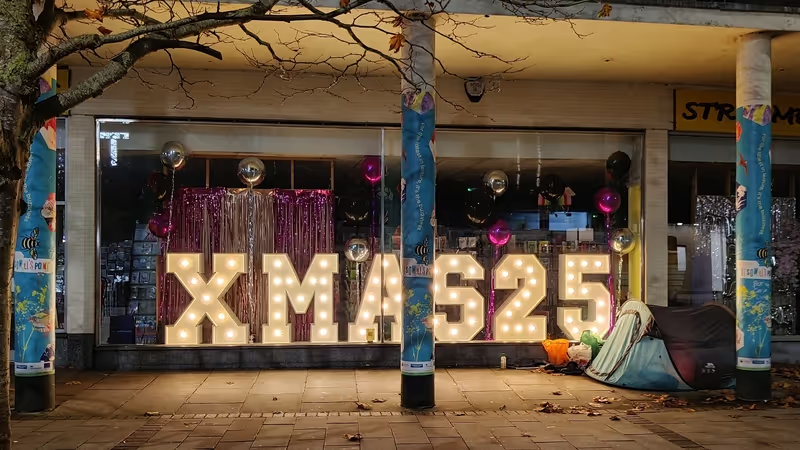Exeter city centre is host to myriad traffic restrictions, many of which exist as a consequence of the closure of the High Street to almost all vehicles apart from local buses.
These restrictions – some of which date from the 1960s – are implemented through Traffic Regulation Orders made by Devon County Council in its role as local highways authority.
They are frequently flouted, with unauthorised vehicles entering pedestrian zones as drivers use alternative routes to avoid the High Street closure.
Among other restrictions, vehicle movements along the short section of Musgrave Row between its junction with Gandy Street and the western end of the lower library car park area are prohibited, with very few exceptions.
Local buses, emergency service vehicles and cycles (but not motor cycles) are exempt.
Taxis (red and black hackney carriages but not private hire cars) and heavy goods vehicles with gross vehicle weights of 7.5 tonnes or more which are servicing premises beside Musgrave Row are also exempt, but only if travelling towards Queen Street, not in the other direction.
Many commercial service and delivery vehicles do not meet the 7.5 tonne threshold and so are not exempt, unless they are being used at specific times for specific tasks in the restricted section of Musgrave Row, such as demolition or highway maintenance.
 Musgrave Row vehicle restrictions area. OpenStreetMap under Creative Commons license.
Musgrave Row vehicle restrictions area. OpenStreetMap under Creative Commons license.
In late May and early June, Exeter Observer carried out a traffic survey at the junction of Little Queen Street and Queen Street, beside the rear entrance to Marks & Spencer.
This location was chosen because it sits at the centre of a matrix of traffic restrictions covering an area from the library to the High Street at one end and Paul Street, beside RAMM, at the other.
Observations of traffic movements were made during eleven separate half-hour periods at different times of day on different days of the week.
An average of 30 vehicles per hour passed the observation point, excluding local buses, just under half of which did not stop. They included an average of ten commercial vehicles below the 7.5 tonne threshold, although some may have had permits allowing access.
An average of twelve private cars per hour ignored the Musgrave Row restrictions, suggesting that around 30,000 prohibited private cars alone pass through the pedestrian zone each year.
 A private car enters the prohibited section of Musgrave Row
A private car enters the prohibited section of Musgrave Row
Enforcement is not straightforward, however. Drivers may argue, with some justification, that road signs do not clearly describe the prohibitions.
At the library end of the restricted section of Musgrave Row the signs enclose images of a car and a motor cycle in a red circle, explained by the Highway Code as conveying “what you must not do”.
Yet at the other end of the section a circular sign with a blue background depicts a bus and a bicycle. The Highway Code says such signs: “generally give a mandatory instruction, such as ‘turn left’, or indicate a route available only to particular classes of traffic”.
Why a red circle is not used at both ends is doubtless covered in the government’s voluminous Traffic Signs Manual. The chapter which deals with regulatory signs alone runs to over 250 pages.
Loading and unloading restrictions in nearby streets also vary unhelpfully.
Access to the section of Queen Street between Paul Street and Little Queen Street is allowed for this purpose at any time, but restricted to the High Street end of Queen Street between 6pm and 10am and to Gandy Street from 4.30pm to 10.30am.
Access for loading and unloading is mostly also limited to goods vehicles weighing 7.5 tonnes or more. But expert knowledge of the regulations is needed to decode the signs as they do not indicate whether the weight limit is a minimum or a maximum.
 Road sign at the Gandy Street end of the Musgrave Row restrictions
Road sign at the Gandy Street end of the Musgrave Row restrictions
Civil enforcement officers employed by Devon County Council can, and do, issue fixed penalty notices where vehicles park illegally. However they have no such powers when vehicles are moving.
Moving traffic order offences are classed as criminal activity and so can only be enforced by the police. However moving traffic order offences other than speeding barely figure in Devon and Cornwall Police records of fixed penalty notices issued to motorists.
Speeding offences consistently appear as all of the top five causes of such notices. In 2022 Devon and Cornwall Police recorded 2,530 such offences in Exeter. During the same period only eleven breaches of other traffic regulations, excluding parking offences, were recorded
In the light of this lacuna in law-breaking prevention the government brought forward legislative changes in 2022 to allow local authorities to use civil enforcement powers against moving vehicles.
Devon County Council has applied to the government to use these powers to enforce traffic regulations at five Exeter sites. A decision on its application will be made in “late 2024 or early 2025”. It does not plan to use them in the Musgrave Row area.
The county council said: “If a member of the public has specific concerns or information we would ask them to contact the police directly as this would allow them to better understand if there is any pattern to the offences and allow the police to target enforcement more effectively.”
 Road sign at the library end of the Musgrave Row restrictions
Road sign at the library end of the Musgrave Row restrictions
The new enforcement powers that the county council plans to wield were introduced “to improve air quality through reduced traffic congestion, and to encourage behavioural shift towards sustainable travel choices”.
To deliver these policy goals, Devon County Council’s Exeter Transport Strategy aims to reduce the “dominance of cars in urban centres and core walking areas” and the county council-led Devon Carbon Plan includes a suite of policies aimed at reducing private car use.
However its decision to end the Heavitree & Whipton active streets trial suggests a reluctance to take steps that are unpopular with local voters.
Meanwhile prohibitive road signs alone seem unlikely to deter drivers and there appears little prospect of enforcement in Musgrave Row under existing, or new, legislation.
Those who hope to take its pedestrian zone signs at face value might be better off sticking to the pavements.










